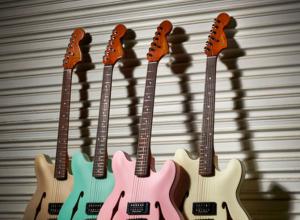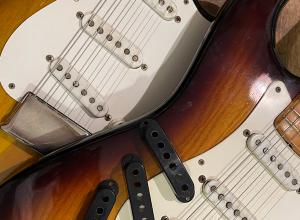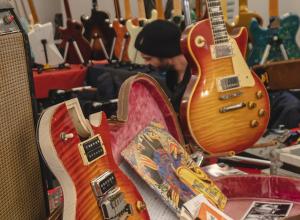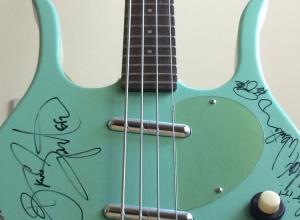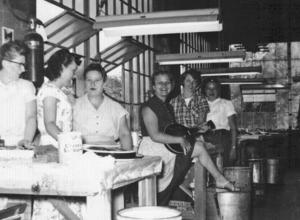Quando le prime chitarre elettriche solidbody, abbinate ai primi potenti amplificatori, iniziarono ad essereutilizzate sul palco, fu immediatamente evidente che il “contrabbasso” risultava, (se confrontato con le leggere ed ergonomiche chitarre elettriche), ormai troppo difficile da trasportare, difficile da suonare e non poteva nemmeno più essere apprezzato quando posizionato accanto a batterie e chitarre amplificate ad alto volume.
Così Leo iniziò a lavorare ad un altro design rivoluzionario, e presentò nel 1951 il “Precision” Fender Bass, la controparte solidbody per Basso delle chitarre Telecaster ed Esquire.
Oggi, per la nostra Vintage Vault, siamo veramente molto felici di potervi raccontare un Fender “Precision” Bass completamente originale dell’inizio del 1952, rinvenuto negli Stati Uniti direttamente dal proprietariooriginale alcuni anni fa.
Neck
Il bellissimo manico in acero monoblocco è stato sicuramente una vera e propria sfida a livello costruttivoper la fabbrica di Fullerton, dal momento che non era affatto facile né scontato creare un manico che potesse al tempo stesso resistere alla tensione delle corde, e rimanere però con un profilo ed una tastiera comodi da suonare.
In ogni caso, costruirono con successo il primo manico per basso “elettrico” mai progettato.
Le caratteristiche ormai collaudate con la Telecaster si ritrovano anche in questo progetto, il manico è infatti completamente rimovibile, dotato di truss rod, e con una paletta che ricorda la forma di una “telecaster”, solamente di dimensioni maggiori.
Questo splendido esemplare che oggi vi raccontiamo è completamente originale, con ancora i tasti ed il capotasto in buone condizioni. È stato suonato e non lo nasconde, ma la verniciatura e le decalcomanieoriginali sono in ottimo stato, e mostrano con fierezza tutto il loro carattere, dalla finitura naturalmenteambrata alle finissime “crepe” del trasparente generate dall’alternanza stagionale di caldo/freddo.
Body
Realizzato a partire da un body di frassino, il corpo del primo “P bass” non presenta smussature o “contour”, ed è quindi in tutto e per tutto assimilabile ad una Telecaster del periodo, se non fosse che Il suo designmostra, per la prima volta, l’idea di Leo per una forma “a doppia spalla mancante”.
I cultori di Fender già sanno quello che stiamo per dire, infatti Leo fin dal 1951 stava lavorando al disegno di quello che sarebbe diventato il suo progetto di maggiore successo, naturalmente stiamo parlando della mitica Stratocaster.
Nell’esemplare visionato oggi, la bellissima finitura “blonde” è invecchiata e ci mostra il famoso look”butterscotch” con una patina incredibile, risultato di un perfetto equilibrio tra usura e segni del tempo.
Dopo le iniziali fatiche e difficoltà per ottenere una finitura liscia e lucida, tra il 1950 e l’inizio del 1951, Fender sviluppò un’eccellente procedura di finitura per il “blonde”, che richiedeva diversi strati, dalprimer, alla tinta di base, alla mano “colore” vera e propria, fino al trasparente finale.
Gli strumenti realizzati tra l’inizio del 1952 ed il 1953 infatti si distinguono sempre per la qualità delle loro finiture, che è davvero impressionante se si considera quanto la fabbrica di Leo fosse ancora ad un livello decisamente “artigianale”.
Hardware
Questo esemplare originale presenta il ponte, le sellette, le meccaniche e la piastra per i controlli di tono e volume, tutti elementi nuovi, disegnati appositamente per il nuovo modello.
Come ogni prodotto Fender, anche il Precision Bass fu dotato ovviamente delle bellissime coperture in metallocromato per bridge e pickup, caratteristica tipica che Leo desiderava per ognuno dei suoi strumenti.
Le parti in plastica
Gli unici elementi in “plastica” nel nuovo modello Fender Bass sembrerebbero essere il battipenna e il “poggiadito” il “thumbrest”, anche se, ad un esame più attento, possiamo apprezzare che il battipenna, che haun design unico che segue il contorno del corpo, è stato realizzato con un singolo foglio di materiale infibra di bachelite nera, esattamente come era d’uso per la Telecaster (e altri modelli), laccato per unaperfetta lucentezza. Questo esemplare mostra un incredibile “weather checking” su tutta la vernice del battipenna. Anche il “poggiadito” è una piccola opera d’arte, poiché è realizzato in legno intagliato elaccato di nero.
Elettronica
Pochissime cose possono battere l’apparente semplicità del circuito del Fender P-Bass, dove un singolo pickupa 4 poli, tipo “telecaster” è posizionato fondamentalmente al centro del corpo dello strumento, controllatosemplicemente da due potenziometri, uno per il volume ed uno per il tono.
Il suono
Il suono di questi primi bassi Fender è ricercato dai musicisti ed utilizzato da innumerevoli professionistiin studio. Sebbene la configurazione del pickup singolo possa sembrare limitante a prima vista, la quantitàdi suoni che è possibile ottenere semplicemente regolando il controllo del tono è a dir poco impressionante.E se hai la possibilità di provarne uno all’interno di un amplificatore Fender Bassman con altoparlante da15″, come abbiamo fatto oggi con il suo compagno, un raro “TV Front” in tweed numero seriale #0081, potrai capire in un istante perché il “Fender Precision Bass” è diventato il riferimento per ogni “Basso Elettrico” realizzato successivamente.
[EN] 1952: Fender “Precision” Bass - serial #0085
When Leo Fender started thinking about building a “solidbody” Electric Guitar back in 1949, his more ambitious idea was to develop a full line of musical instruments to suit virtually every musician’s need or music style.
When the first solidbody electric guitars, paired to the early powerful amplifiers started to be used on stage, it was immediately apparent that the old styled “double bass”, which is one of the largest traditional instruments, was hard to transport, difficult to play, and couldn’t just be heard anymore when placed next to drums and loud amplified guitars.
So Leo started to work to another revolutionary design, and came out in 1951 with the “Precision” Fender Bass, the solidbody counterpart of his Telecaster and Esquire.
Today, on our Vintage Vault Bench, we are excited to have a fully original early 1952 Fender “Precision” Bass, found from the original owner a few years ago.
The Neck
The beautiful one piece maple neck has been surely quite a challenge for the Fullerton factory, since it wasn’t easy to compensate the heavy gauged strings tension while obtaining a playable and comfortable neck profile. In any case, they successfully built the first ever designed, truss rod equipped detachable “bass” electric guitar neck, shaped as a bigger sized “telecaster” one. This gorgeous example is in fully original conditions, with still the original frets and nut in place. It’s been played and it shows, but the original lacquer and decals are in excellent shape, with plenty of character provided by the naturally ambered finish and the beautiful “weather checking” all throughout.
The Body
The body design incorporates Leo’s idea for a “double cut” shape, that would eventually lead to the creation of the Stratocaster a couple years later, but, in this very case, it was built as a “slab” shaped ash body with regular “telecaster”, slightly rounded edges and no “contour”.
The beautiful “blonde” finish has aged to the famed “butterscotch” look, and features amazing patina, playing wear, and plenty of fantastic “weather checking”.
After the initials struggles to obtain a smooth and glossy finish, back in 1950 and early 1951, Fender developed an excellent finish procedure for “blonde”, that required several different coats, from the primer, to the “sand” colored undercoat, to the “Blonde” color coat, and ultimately to the clear coats. The instruments made between early 1952 and 1953 always stand out for the quality of the craft, which is impressive considering that the Factory was quite small back then.
The Hardware
This full original example features the newly designed bridge, saddles, tuners, and control plate, that Leo created specifically for the new bass model, fitted with the beautiful chromed metal covers for bridge and pickup, a typical feature that Leo wanted for all his stringed instrument.
The Plastic Parts
The only “plastic” elements in the new Fender Bass model would seem to be the pickguard and thumb rest, although, upon closer inspection, we can appreciate that the pickguard, which has a unique design that follows the body outline, was made with a single sheet of black bakelite fiberboard material, just exactly they were doing for the Telecaster (and other models), lacquered over for perfect sheen. This example shows an incredible weather checking all over the lacquer on the pickguard. The thumb rest is also a small piece of art, since it’s made out of carved wood and lacquered in black.
The Electronics
Very few things can beat the apparent simplicity of the Fender P-Bass circuit, where a single, “telecaster” pickup is placed basically in the middle of the Bass body, controlled by two pots, one for volume and one for tone.
The Sound
The sound of these early Fender Basses is sought after by players and used by countless pro musicians in the studio. Although the single pickup configuration might appear limiting at first glance, the amount of tones you can obtain by simply adjusting the tone control is impressive to say the least. And if you’ve the chance to try one inside a Fender Bassman Amplifier with 15” speaker, like we did today with his companion, a rare “TV front” tweed amp serial number #0081, then you will definitely understand why the “Fender Precision Bass” became the ultimate reference for any “electric bass” that has ever been built after. |
 VINTAGE VAULT
VINTAGE VAULT
 SHG MUSIC SHOW
SHG MUSIC SHOW
 PEOPLE
PEOPLE
 STORE
STORE
 - Privacy - Accordo.it Srl - P.IVA 04265970964
- Privacy - Accordo.it Srl - P.IVA 04265970964
![1952: Fender “Precision” Bass - seriale #0085 [IT-EN] 1952: Fender “Precision” Bass - seriale #0085 [IT-EN]](https://www.accordo.it/cloud-assets/730x450/redazionea5/images/deco/104711_precision-g.jpg)




























